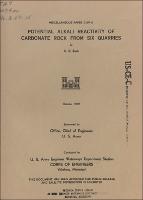Please use this identifier to cite or link to this item:
https://hdl.handle.net/11681/11447| Title: | Potential alkali reactivity of carbonate rock from six quarries |
| Authors: | United States. Army. Office of the Chief of Engineers Buck, Alan D. |
| Keywords: | Alkali-aggregate reactions Carbonate rocks Rock tests |
| Publisher: | Concrete Laboratory (U.S.) Engineer Research and Development Center (U.S.) |
| Series/Report no.: | Miscellaneous paper (U.S. Army Engineer Waterways Experiment Station) ; C-69-15. |
| Description: | Miscellaneous paper Abstract: Forty-one carbonate rock samples from six quarries in Virginia and Kentucky were tested for potential alkali-carbonate rock reactivity that may take place when certain carbonate rocks are used as aggregates in concrete. Expansion that accompanies this reaction may be deleterious to concrete, so criteria have been established to detect potentially reactive rock (see Appendix A). Petrographic, physical, and chemical data were developed for each sample. In most instances, expansion data were obtained by periodic measurement of length changes of pairs of small rock specimens that were stored in sodium hydroxide solution. Three of the samples were represented by 5 length-change specimens each. Data were examined and compared to determine if criteria for identifying potentially reactive rocks appeared to be effective. In general, but with a few exceptions, the validity of the criteria was confirmed. Failure of criteria to always identify reactive rocks suggests that (a) tests for determining potential reactivity of rock samples containing detectable amounts of dolomite and having an essentially limy mud matrix should include length-change determinations, and (b) length-change determinations should be made on at least two specimens from each sample. These specimens should preferably be from adjacent locations. Length-change data indicated that the material from one of the quarries would not be expected to participate in expansive alkali-carbonate rock reaction. Material from the other five quarries is expected to contain greater or lesser amounts of rock that could participate in this reaction in varying degrees. Based on criteria that have been proposed for application in such cases, and in the absence of service record data on the performance of aggregate from these sources, the quarries are rated as follows: quarry 2, no indication of reactivity; quarry 3, approximately 15% potentially reactive rock; quarry 5, approximately 24% potentially reactive rock; quarry 1, approximately 30% potentially reactive rock; quarry 6, over 50% potentially reactive rock; and quarry 4, approximately 70% potentially reactive rock. |
| Rights: | Approved for public release; distribution is unlimited. |
| URI: | http://hdl.handle.net/11681/11447 |
| Appears in Collections: | Miscellaneous Paper |
Files in This Item:
| File | Description | Size | Format | |
|---|---|---|---|---|
| MP-C-69-15.pdf | 1.35 MB | Adobe PDF |  View/Open |